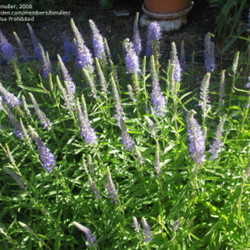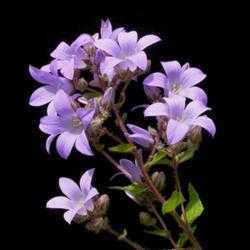(Editor's Note: This article was originally published on February 20, 2009. Your comments are welcome, but please be aware that authors of previously published articles may not be able to respond to your questions.)
The image on the right is of Meconopsis betonicifolia, considered the Holy Grail of Poppydom. Who could resist its fabulous blue color? Certainly not I. | The famous Himalayan Blue Poppy |
If you've been purchasing your spring bedding plants and hardy perennials at garden centers or via mail order in the past, why not try your hand at starting a few varieties from seed indoors this year? It's fun to get a head start on the upcoming garden season and will lift your spirits when you see those seedlings you've been nurturing poke their little green heads up through the soil. In these times of difficult economic circumstances, the fact that plants grown from seed can be much less expensive than those in bought in stores might be another motivator to try growing plants from seed. However, as my experience above illustrates, there are pitfalls that can trip you up. Growing seedlings indoors requires high quality seeds, a well-drained, disease-free growing medium, containers, proper temperature and moisture conditions, and adequate light.
The aim of this article is to arm you with knowledge about the ease of growing various varieties and to provide links (located at the end of this article) to helpful seed-starting resources.
In Table 1 below, I've listed flowering plants alphabetically and categorized them as (1) easy-to-grow, (2) some experience necessary, and (3) not worth the bother. With the category (1) plants, you simply sow the seed at room temperature, provide appropriate light, and don't let the seeding medium dry out. Category (2) plants bear seed that may be very tiny, difficult to handle, and often require cold treatment in order to germinate. The third category lists seeds that may not come true to the mother plant, may require a complicated temperature treatment (perhaps multiple shifts from cold to warm temperatures), may require skilled light treatment, may take an unusually long time to germinate (up to a year or more), or may not reach flowering size for many years (peony seed, for example, takes about five years).
TABLE 1Degree of Difficulty | Botanical Name | Common Name |
EASY | ||
| Achillea | Yarrow |
| Alcea | Hollyhock |
| Alyssum | Perennial Alyssum |
| Anthemis | Perennial Marguerite |
| Aquilegia | Columbine |
| Arabis | Wall Cress |
| Armeria | Thrift |
| Aster | Aster |
| Aubrieta | Rock Cress |
| Aurinia | Basket-of-Gold |
| Bellis | English Daisy |
| Campanula carpatica | Carpathian Bellflower |
| Campanula persicifolia | Bellflower |
| Catananche | Cupid's Dart |
| Centaurea | Cornflower |
| Centranthus | Red Valerian |
| Cerastium | Snow-in-Summer |
| Coreopsis | Tickseed |
| Cynara | Cardoon/ Globe Artichoke |
| Dianthus | Pinks/ Carnations/Sweet William |
| Digitalis | Foxglove |
| Doronicum | Leopard's Bane |
| Echinacea purpurea | Purple Coneflower |
| Echinops | Globe Thistle |
| Erigeron | Fleabane Daisy |
| Erysimum allionii | Siberian Wallflower |
| Gaillardia | Blanket Flower |
| Geum | Geum |
| Gypsophila | Baby's-Breath |
| Helenium | Helen's Flower |
| Hesperis | Dame's Rocket |
| Heuchera | Old-fashioned Coral Bells |
| Kniphofia | Torchlily |
| Leucanthemum | Shasta Daisy |
| Liatris | Blazingstar |
| Limonium | Sea Lavender |
| Linum perenne | Blue Flax |
| Lunaria | Money Plant |
| Lupinus | Lupine |
| Lychnis | Campion |
| Malva | Mallow |
| Monarda | Beebalm |
| Myosotis sylvatica | Forget-me-not |
| Origanum | Oregano |
| Papaver | Poppy |
| Physostegia | Obedient Plant |
| Polemonium | Jacob's Ladder |
| Potentilla | Cinquefoil |
| Rudbeckia hirta | Gloriosa Daisy |
| Salvia (Perennial) | Sage |
| Stachys | Lamb's Ears |
| Tanacetum | Painted Daisy, Feverfew |
| Thymus serpyllum | Mother-of-Thyme |
| Verbascum | Mullein |
| Verbena | Verbena |
| Veronica | Veronica, Speedwell |
| Viola | Winter Pansy |
MORE DIFFICULT | ||
| Acanthus | Bear's-Breeches |
| Aconitum | Monkshood |
| Alchemilla | Lady's Mantle |
| Alstroemeria | Peruvian Lily |
| Anemone | Windflower |
| Angelica | Angelica |
| Arum | Arum |
| Aruncus | Goat's Beard |
| Asarum | Wild Ginger |
| Asclepias | Milkweed |
| Astrantia | Masterwort |
| Baptisia | False Indigo |
| Bergenia | Bergenia |
| Buddleia | Butterfly Bush |
| Caltha | Marsh Marigold |
| Caryopteris | Bluebeard |
| Chelone | Turtlehead |
| Chrysogonum | Golden Star |
| Cimicifuga | Bugbane |
| Clematis | Clematis |
| Corydalis | Fumitory |
| Crambe | Sea Kale |
| Cyclamen | Cyclamen |
| Delphinium | Delphinium |
| Dicentra | Bleeding Heart |
| Dictamnus | Gas Plant |
| Dodecatheon | Shooting Star |
| Eremurus | Foxtail Lily |
| Eryngium | Sea Holly |
| Eupatorium | Boneset/Joe Pye Weed |
| Euphorbia | Spurge |
| Filipendula | Meadowsweet |
| Fuchsia | Fuchsia |
| Gaura | Butterfly Gaura |
| Gentiana | Gentian |
| Geranium species | Cranesbill |
| Goniolimon | German Statice |
| Gunnera | Gunnera |
| Helianthemum | Rock Rose |
| Helianthus | Perennial Sunflower |
| Heliopsis | False Sunflower |
| Helleborus | Christmas- & Lenten Rose |
| Heuchera hybrids | Fancy-leaf Coral Bells |
| Hibiscus | Hardy Hibiscus |
| Hypericum | St. John's-Wort |
| Iberis | Perennial Candytuft |
| Incarvillea | Hardy Gloxinia |
| Iris species | Iris species |
| Jasione | Shepherd's Bit |
| Kirengeshoma | Waxbells |
| Knautia | Crimson Scabious |
| Lathyrus | Perennial Sweet Pea |
| Lavandula | Lavender |
| Lavatera | Tree Mallow |
| Leontopodium |
|

















